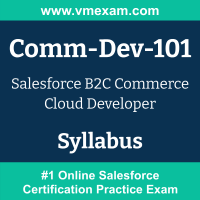 The Salesforce Comm-Dev-101 exam preparation guide is designed to provide candidates with necessary information about the B2C Commerce Cloud Developer exam. It includes exam summary, sample questions, practice test, objectives and ways to interpret the exam objectives to enable candidates to assess the types of questions-answers that may be asked during the Salesforce Certified B2C Commerce Cloud Developer exam.
The Salesforce Comm-Dev-101 exam preparation guide is designed to provide candidates with necessary information about the B2C Commerce Cloud Developer exam. It includes exam summary, sample questions, practice test, objectives and ways to interpret the exam objectives to enable candidates to assess the types of questions-answers that may be asked during the Salesforce Certified B2C Commerce Cloud Developer exam.
It is recommended for all the candidates to refer the Comm-Dev-101 objectives and sample questions provided in this preparation guide. The Salesforce B2C Commerce Cloud Developer certification is mainly targeted to the candidates who want to build their career in Salesforce Developer domain and demonstrate their expertise. We suggest you to use practice exam listed in this cert guide to get used to with exam environment and identify the knowledge areas where you need more work prior to taking the actual Salesforce B2C Commerce Cloud Developer exam.
Salesforce Comm-Dev-101 Exam Summary:
|
Exam Name
|
Salesforce B2C Commerce Cloud Developer |
| Exam Code | Comm-Dev-101 |
| Exam Price |
Registration fee: USD 200 Retake fee: USD 100 |
| Duration | 105 minutes |
| Number of Questions | 65 |
| Passing Score | 65% |
| Recommended Training / Books |
Salesforce B2C Commerce documentation B2C Commerce Developer with SFRA - CCD102 Manage and Merchandise a B2C Commerce Cloud Store (CCM101) |
| Schedule Exam |
Kryterion Webassessor PEARSON VUE |
| Sample Questions | Salesforce Comm-Dev-101 Sample Questions |
| Recommended Practice | Salesforce Certified B2C Commerce Cloud Developer Practice Test |
Salesforce B2C Commerce Developer Syllabus:
| Section | Objectives | Weight |
|---|---|---|
| B2C Commerce Setup |
- Given a sandbox environment, configure an IDE to use WebDAV to deploy cartridges to the correct version directories. - Given a sandbox instance and data import files, import files using the Business Manager Import/Export modules. - Given the code for a storefront site, add the correct sequence of cartridge names to the provided cartridge path. - Given a sandbox environment, use the Business Manager to add a new site to the instance, configuring the default currency and taxation type according to business requirements. - Given a recently created B2C site, assign the storefront data configurations according to business requirements. |
11% |
| Work With a B2C Site |
- Given a Business Manager task, work with the product data model to manage products and product search model, their categorization, and associated inventory and pricebooks. - Given a configuration for tasks, such as payment and shipping information, use Business Manager to enable shoppers to complete storefront orders. - Given a configuration task, use Business Manager to work with Content Assets, Page Designer, Content Slots, and Content Folders. |
12% |
| Data Management Using Business Manager Usage |
- Given a business requirement, modify site search preferences and settings to enable searching for a specified term or product attribute. - Given a business requirement, create and configure a new search refinement and sorting definition that can be used on the storefront. - Given a debugging requirement or code, configure the logging categories and access the logs in Business Manager. - Given business requirements, extend the storefront to expose a new attribute on an existing system object type. - Given a business need to store custom data, determine if a custom object is needed and create and configure as required. - Given a problem or performance issue and data, use relevant tools to inspect code performance and determine and implement solutions (cache configuration, profilers, etc.) to resolve this issue. - Given a specification and a sandbox instance, configure OCAPI permissions for Data and Shop APIs. - Given a service configuration, recognize how they are applicable to the development process. |
24% |
| Application Development |
- Given a development task, code ISML templates that use functionality, such as local include, remote include, components, and other ISML tags. - Use debugging best practices and techniques to troubleshoot scripts and controllers and verify outcomes. - Given a requirement, create and extend the functionality of a JavaScript controller that leverages models, decorators, factories, or helpers following API best practices, and renders a template or returns a JSON response. - Given a business requirement and design for a new marketing page, develop page types and components to allow a marketer to build a page with the Page Designer tool. - Given a requirement to accept, validate, and persist information from a storefront customer, modify the appearance of a form, add validation and cross-site request forgery (CSRF) protection, and use bindings to process fields. - Given localization requirements, implement and enhance templates, form definitions, static files, properties files, and persistent object attributes to ensure that pages are displayed in the expected language. - Given a logging task and existing configuration, write code that logs non-sensitive data to custom log files with different log levels. - Integrate, deploy, and use a service instance based on a given requirement. - Given a use case, extend functionality or capture an event using hook extension points. - Given code that violates documented best practices, identify the issues and modify the code to conform with best practices including performance and scalability. - Given a business requirement, use OCAPI Shop and Data APIs to enable interoperability with an external system. - Given a business requirement to perform a scheduled task, develop jobs and code job scripts. |
53% |
